Free Online Productivity Tools
i2Speak
i2Symbol
i2OCR
iTex2Img
iWeb2Print
iWeb2Shot
i2Type
iPdf2Split
iPdf2Merge
i2Bopomofo
i2Arabic
i2Style
i2Image
i2PDF
iLatex2Rtf
Sci2ools
BMVC
2010
2010
Active 3D Segmentation through Fixation of Previously Unseen Objects
We present an approach for active segmentation based on integration of several cues. It serves as a framework for generation of object hypotheses of previously unseen objects in natural scenes. Using an approximate Expectation-Maximisation method, the appearance, 3D shape and size of objects are modelled in an iterative manner, with fixation used for unsupervised initialisation. To better cope with situations where an object is hard to segregate from the surface it is placed on, a flat surface model is added to the typical two hypotheses used in classical figure-ground segmentation. The framework is further extended to include modelling over time, in order to exploit temporal consistency for better segmentation and to facilitate tracking.
Approximate Expectation-maximisation Method | BMVC 2010 | Classical Figure-ground Segmentation | Computer Vision | Flat Surface Model |
| Added | 10 Feb 2011 |
| Updated | 10 Feb 2011 |
| Type | Journal |
| Year | 2010 |
| Where | BMVC |
| Authors | Mårten Björkman, Danica Kragic |
Comments (0)

